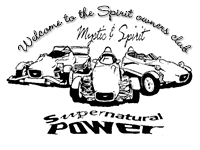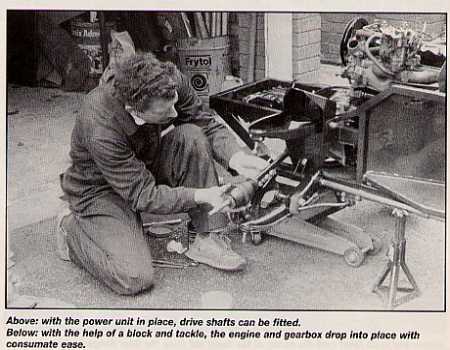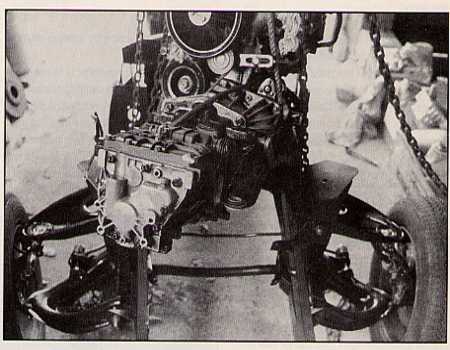 Building
a Kindred Spirit Part 2/2
Building
a Kindred Spirit Part 2/2
|
Above: with the power unit in place, drive shafts can be fitted. Below: with the help of a block and tackle, the engine and gearbox drop into place with consumate ease. more horizontal than it is on the Renault. In consequence, the entire tube is dependent on a single point of fixing which is some distance from the wheel itself. I made a couple of modifications to improve the strength of the 'U' bracket before bolting it to the plate on the chassis framework. Now it's true that up-and-down steering wheel movement didn't unduly upset the MOT tester but I think there's room for improvement here This especially true when less agile owners rest heavily on the wheel while legging it over the side Theoretically you can fit the original steering wheel, but it looks huge. A shirt button bound in leather is more appropriate and that's exactly what the 10" Mounifield wheel looks like. Hudson supplies this as an optional extra. Several hundred miles later I'm still getting used to this diminutive disk, but it certainly looks right for the car. The purist might be sorry to discover that the wheel isn't central in the cockpit, but no-one ever notices this slight assymmetry - myself included As Julian Webb pointed out when I checked the irregularity with a tape measure, many production cars have off-line wheels as well. And he's perfectly correct of course. Petrol Tank The kit includes one of the sturdiest, most shapely tailor made tanks you'll ever see Its 3 5 gallon capacity gives a range around 130 miles, which some trivial pursuitist claimed is a single lap (anti clockwise) round the M25. It's also true to say if I could resist all temptation to drive this 'fun cars 1289cc engine to its fullest potential, i.e. fast, I would probably exceed the consistent 38.8 mpg attained to date. On the other hand, this isn't meant to be an entrant for the Shell economy run and you can't exactly call it thirsty. Altering the original float and sender unit iS one of those jobs you can do when bad weather keeps you indoors Hudson's instructions are clear about the modification although my petrol guage ceases to register petrol when the tank contents drop below half way. So at the moment I make a mental note of mileages at top-up time. Sometime I'll get round to rechecking the float arrangement to see if the wire can be bent in a different manner. Brackets welded to the tank leave you the job of drilling the chassis in order to fix it in place. Any risk of movement or rattle was reduced by sandwiching some rubber sheet between the brackets and the point of contact on the chassis. An old piece of inner tube is ideal for the job. As regards the flexible hose which connects up the filler tube to the tank on the Renault 5, this is a bit on the short side However, a trip to a breaker's yard produced a longer piece taken from a Datsun. It's worth mentioning at this point that you mustn't use ordinary radiator hose because the material isn't suitable for petrol. At the upper end of the filler tube, the original filler flange was re-used after giving it the wire brush and paint treatment.
Hudson's list of bits to rescue from the donor vehicle seems to have overlooked this important component. Similarly the original fuel line was sound enough to use again - which was rather fortunate New plastic tubing always seems unreasonably expensive. The fuel line was fitted to the chassis using small 'P' clips and self tapping screws. But here lies a problem. Automotive suppliers in my patch never seem to stock these clips so you may need to order them through one of our components advertisers. For example, Wayne Roper (Europa Cars) will send them through the post Looking at the route taken by the petrol feed, it passes around the upper rail of the rear frame before ducking underneath the offside suspension support. Thereafter it passes out of sight along the offside section of the chassis. In places, rubber piping was sleeved onto the plastic fuel line to give additional protection against chafing. This was particularly the case when it was routed through a hole drilled in the side plate which supports the front torsion bar Installing engine and gearbox To celebrate building the third kit car to date, it was decided to avoid the risk of injury by purchasing a block and tackle rather than a surgical truss. Second hand, of course. Admittedly you can borrow various items from your local tool hire depot for lifting engines. But after a bit of haggling, a block and tackle from an old corn mill came in my direction for thirty quid With this invaluable bit of Britain's industrial heritage roped up to a beam in the garage, the engine and gearbox were gracefully lowered into |
 |
|
|
|
|
FACT FILE Owner's Club currently being launched by: Philip Loughlin, 142 New Road, Hetherset, Norwich, NR9 3HG. Kits supplied in UK to date (as at September 1991) - over 50. Over 20 kits currently being supplied to Germany. Approvals: The vehicles have recently been successful in gaining TUV approvals after testing and examination in Germany. Kit prices: Free Spirit single seater £1200 (ox works; ox VAT). Kindred Spirit two seater £1450 (ex works: ex VAT). The kit includes approaching 40 parts and price includes the factory modification of the Steering column. Brake pedal, and nearside rear suspension arm. Body panels supplied in grey. Colours £35 extra (ox VAT). Chassis supplied in bare metal. Primed £15 extra, painted £45 extra, powder coated by arrangement. (Prices ex VAT), Parts not included in the kit: Mini hand brake (for Kindred Spirit only) (Breaker's yard). Seats (Originals can be heavily modified, but Speedograph Richfield make special front seats with thigh indents for Kindred Spirit rear passenger comfort; Speodograph Richfield will also upholster the rear seat GRP bucket which comes with the kit. The new front seat re-uses the original sliding gear). Brackets to support radiator and expansion bottle (make from scrap). Expansion bottle - Marina fits the space well. Bulb holders for rear lights (Lucas supplier), New brake pipe and brackets (Kit Car suppliers). Front grille (ingenuity using anything from breakers). Battery (original can be used, but compact Exide Torque start highly recommended). Front shockers - Gordini type from Renault dealer. Exhaust - Mini single box system but with Hudson down pipe. Optional parts from Hudson: Down pipe - £17. Racing mirrors - £16 each. Mount field steering wheel - £17. Mount field steering wheel boss - £7. Headlight bowls £9 each. Hella squire headlights - £17 each. Front indicators - £10 pair (or Yamaha motorcycle dealer). Free Spirit transfers - £3.60 each. Kindred Spirit transfers - £4.50 each. Prices quoted exclude VAT. Special Hudson services: Donor cars can usually be supplied and delivered by arrangement - typical cost £50 to £100 plus transport. Chassis alone can be supplied in advance for around £950. |
